In previous
articles I've highlighted the worrying rise in deaths from heart failure. This article adds deaths from both cirrhosis (liver damage) and diabetes to the 'watch' list.
Using data from the Department of Health Improvement and Disparities (DHID)
website I've compared the expected number of deaths from the end of March to the end of September 2020, with the registered number of deaths for the commensurate 28 weeks in 2023.
The data cover 14 causes of death. In Figure 1 you can see that the increase in deaths from heart failure at 26% leads the field, but it's closely followed by cirrhosis and other liver diseases at 22% and diabetes deaths at 19%.
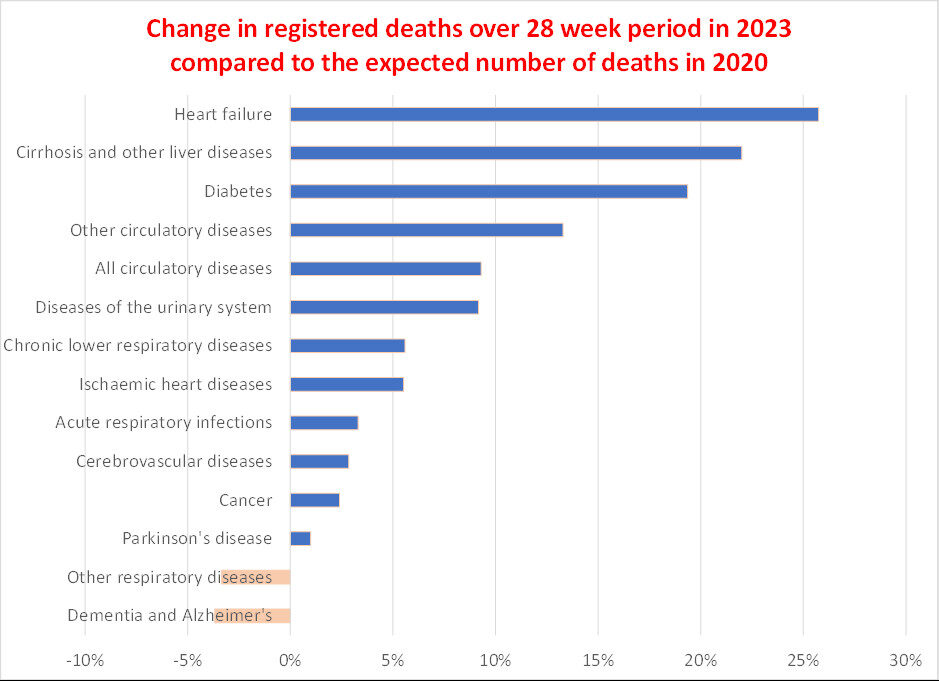
Figure 1
A very good question would be why I'm comparing 2023 actuals with 2020 expected numbers, rather those for 2023. The answer is that the expected levels are calculated as an average of prior years, so, if you have a rising trend the average goes up progressively. The net result of this 'inflationary' pressure is to understate the increase or decrease in deaths over the coming years. This results in the classic 'frog boiling' as things progressively, though imperceptibly worsen.
In the following charts I've separated out the 'inflationary' increase from the 'excess'. In that way
it's apparent that the overall changes from 2020 are far more significant than the reported level.Figure 2 shows that 29,582 people were expected to die from heart disease in the 28 weeks from the end of March to the end of September 2020. In 2023 the expected level of deaths had increased by 2,027, a 7% jump. In the event, in 2023 a further 5,539 people died of heart failure, these are the 'excess deaths'.
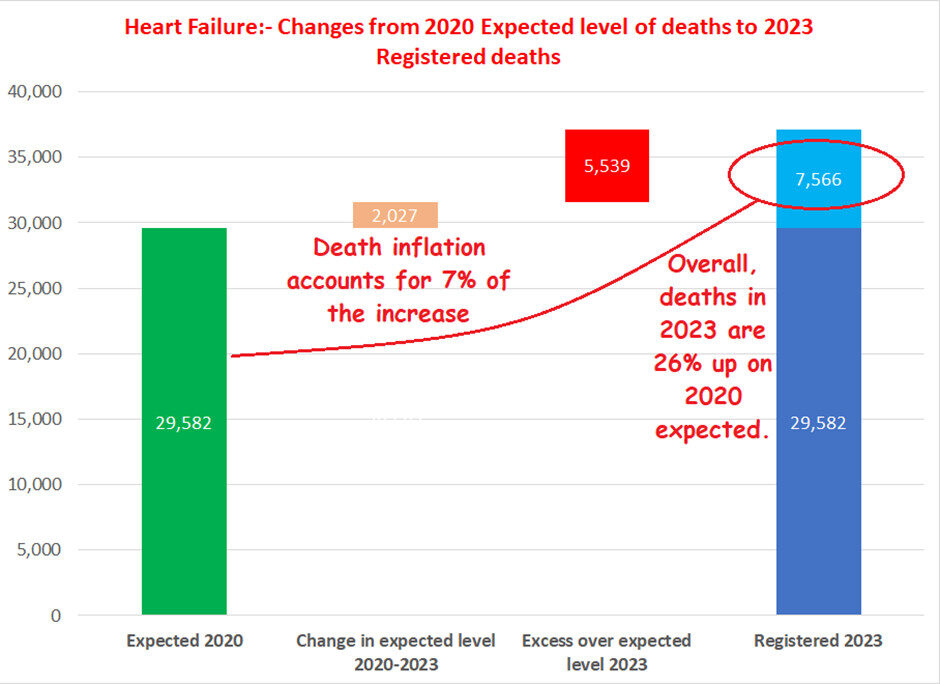
Figure 2
So, in 2023, from the end of March to the end of September a total of 37,148 deaths from heart failure were registered (7,566 + 29,582). That's 19% higher than the 2023 expected level but 26% higher than the expected level in 2020 number. Extrapolate 7,566 deaths from 28 to 52 weeks and we see that we're on target for over 14,000 extra deaths from heart failure.
Deaths from cirrhosis also show a 7% 'inflationary' increase and a further 15% 'excess' deaths on top of that.
A 22% increase in deaths from cirrhosis seems like an awful lot! Cirrhosis is a fairly slow burn condition. Another un-foreseen consequence of lockdown?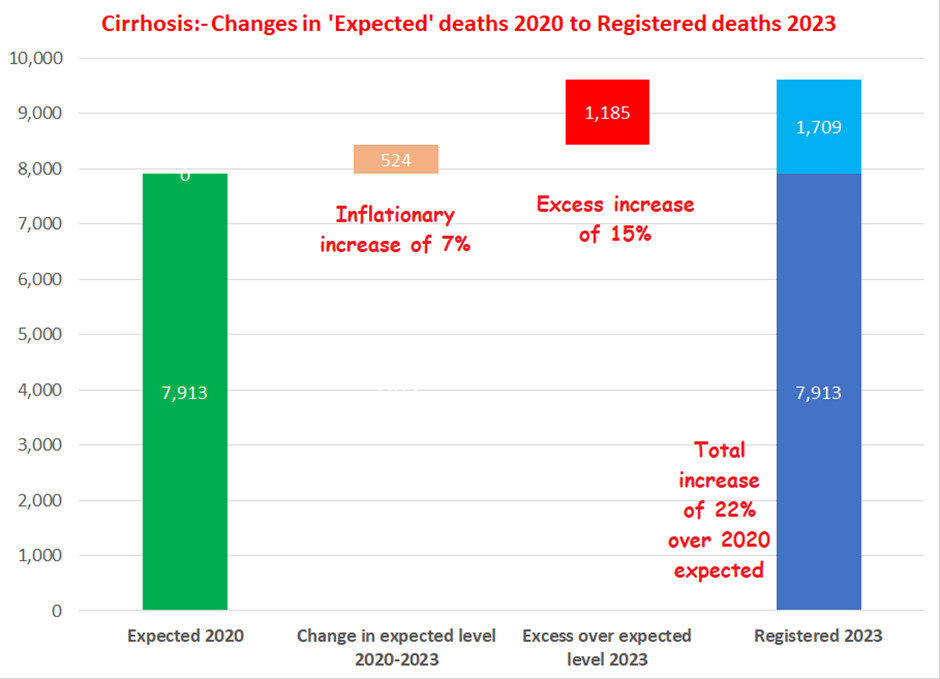
Figure 3
Diabetes shows a total increase of 19% over the 2020 expected number of deaths. Some 12% of this increase is 'inflationary' with a further 7% being recorded as 'excess' this year.
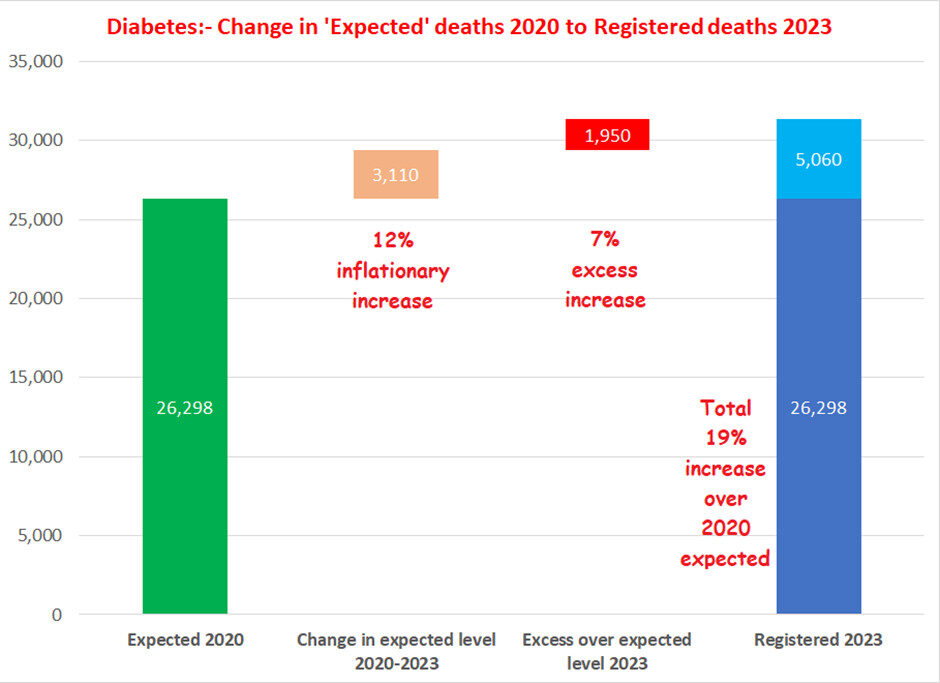
Figure 4
Again, let's extrapolate that 5,060 extra deaths to 52 weeks and we see that we're on schedule for over 9,000 extra deaths from diabetes. Add the 14,000 extra heart failure deaths to the 3,000 cirrhosis deaths and the 9,000 diabetes deaths and that's over 26,000 excess deaths from these three conditions alone.
The purpose of these charts is to highlight that it's important to look behind the headlines. A headline that deaths from diabetes are up 7% may not set the pulses racing, but when it's put in context of a 19% increase over three years then you just might sit up and take some notice, and if you're at risk, do something about it!
Finally, let's look at cancer deaths. Cancer has been making the headlines of late. We've had both
Professor Angus Dalgleish and
Professor Karol Sikora flagging up concerns over cancer but from rather different positions.
Dalgleish attributes harm in part to the vaccines themselves, whereas Sikora has consistently pointed to the 'non-pharmaceutical interventions' leading to delays in diagnosis and treatment as being the true villains of the piece.However, as Figure 5 demonstrates, there's been very little change in cancer deaths, just 2.3% up on the 2020 expected level. Indeed, registered deaths during our 28 week 2023 period have been 381 lower than the expected level.
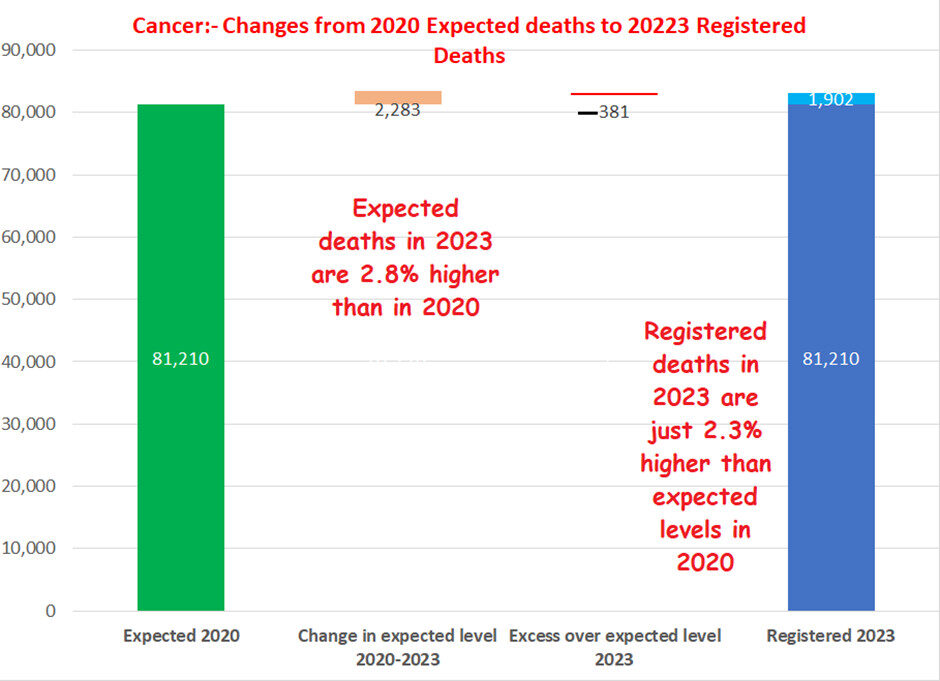
Figure 5
What does all this tell us?
Heart failure, cirrhosis, diabetes and cancer are all linked to lifestyle choices. We know that mRNA can cause heart problems, indeed Pfizer themselves warn about myocarditis, Figure 6 is taken from its
website; one wonders how many school-age kids were warned of this association with myocarditis before giving their 'informed' consent to getting vaccinated?
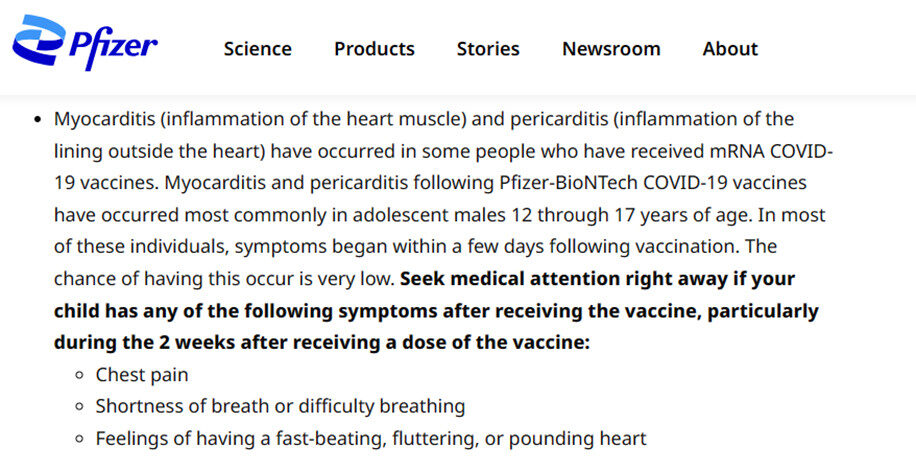
Figure 6
However, the significant increases in cirrhosis and diabetes may well indicate that it's been the unintended consequences of lockdown that's had the most impact as people's lifestyle choices became increasingly harmful.
Lifestyle, vaccines or failures in medical care, the legacy of the over-reaction to Covid will continue to reverberate for years to come.
Reader Comments
The only problem with that is to make the metric work they use an age range of 1-19......how many 19 year old children do you know? And only overdose is higher than it was in 1995 with gun deaths and car accidents much higher back then.
The only folks trying to prove a "narrative" are the scumbags in DC.
What about the fact that the world poplulation has increased by 260 million since 2020? Would that not increase the death rates?
What about the fact that obesity has increased 25-30% since 2018? Would that not increase the death rate?
Heart failure and diabetes are the number 1 killer of the elderly and the obese.
All child deaths in England between 2019 and 2022, found overall mortality dipped during the pandemic due to a decrease in infectious illnesses, but that numbers of deaths have since returned to pre-pandemic levels. This included a 32% increase in trauma deaths.
The link between child mortality and poverty was well-established and the latest figures are a “tragic” result of worsening inequalities.
Child mortality is highest in the poor sections which are the least vaccinated.
The main cause for heart failure, cirrhosis, diabetes and cancer is from society becoming more and more physically inactive which is why there's an increase in chronic disease risk.
A chronic disease is an illness that is not contagious, usually of long duration, progresses slowly, and is typically a result of genetics, environment, or poor lifestyle.
In either case of disease prevention or treatment, physicsl activity and regular exercise provide a higher quality of life and increased longevity.
It's by the New England Journal of medicine
The link does say:
Although every effort has been made to estimate the expected deaths as robustly as possible, mortality rates do vary considerably from year to year and we have no way of knowing what would have happened. Excess deaths are based on the assumption of an 'average' year, given the trends in death rates and demographic change.
Meaning this article is based on an assumption which doesn't mean a damn thing. What the author is assuming is that the audience is dumb and will believe this drivel.
NHS England, is short of 12,000 hospital doctors and more
than 50,000 nurses and midwives. The 2021 NHS staff survey in England found that just 27 per cent of staff say there are enough people in the organisation for work to be carried out effectively.
This has led to rises in waiting times for emergency care and ambulance responses. Ambulances have been held up in hospitals because they can’t transfer patients into emergency departments that have reached full capacity. “We know that the time it takes for an ambulance to reach someone in cardiac arrest affects their chance of survival.
Age ratio [Link]
Obesity rates
[Link]
Everything but the shot ...
And ODD, of course [Link] !
Quote: "Adderall, a stimulant containing equal parts of racemic amphetamine and dextroamphetamine, can cause irritability, anger, lowered empathy, self-awareness, and even violent outbursts". This "only" occurs when the dosage is wrong.
However the education has become garbage as this is where "white privilege" arose before it became mockingbird media.
I'd also say that there is a 20-25% chance I'm wrong.
O, Typhoid Mary, It was said that you carry a germ, so they had to lock down
O, Spanish Flu dead, botched vaccine, some have said. On each corpse a confusing frown
O, Covid test mice. What was done, it sure ain't nice. Some must die, so to serve orb and crown
O, serf for the WHO, who will tell you what to do, If you meekly take this, lying down